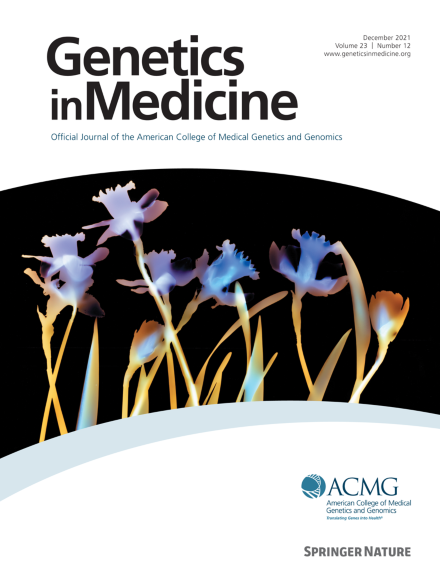电子健康档案中多重先天性异常病例分类的系统方法。
IF 6.6
1区 医学
Q1 GENETICS & HEREDITY
引用次数: 0
摘要
目的:先天性异常(CAs)影响约3%的活产婴儿,是婴儿发病率和死亡率的主要原因。许多人患有多种先天性异常(MCA),即两种或两种以上不相关的先天性异常,但如何在电子健康记录(EHR)中系统地识别这些人尚无共识。我们开发了一种可扩展的方法来表征电子病历中的MCA,从而大大提高了我们对MCA遗传和流行病学基础的理解。方法:从范德比尔特大学医学中心的匿名电子病历数据库中,我们评估了三种不同的MCA分类方法,包括一种新的方法,该方法消除了“次要与主要”的区分及其相关的临床应用和人群特征。使用全表型关联研究,我们评估了与先前分类的“轻微”CAs相关的表型。结果:我们提出的在EHR中识别MCA的通用方法是准确的(PPV= 97.1%),与更高的医院利用率(41%接受住院治疗)相关,并且捕获了ca的颗粒模式。我们的方法在两个独立的队列中进行了二次应用。结论:我们开发了一种在电子病历中全面识别MCA患者的方法,使研究人员能够更好地研究MCA的遗传病因。此方法可以跨带有帐单代码的EHR数据库应用。本文章由计算机程序翻译,如有差异,请以英文原文为准。

Systematic method for classifying multiple congenital anomaly cases in electronic health records
Purpose
Congenital anomalies (CAs) affect approximately 3% of live births and are the leading cause of infant morbidity and mortality. Many individuals have multiple CAs (MCA), a constellation of 2 or more unrelated CAs; yet, there is no consensus on how to systematically identify these individuals in electronic health records (EHRs). We developed a scalable method to characterize MCA in the EHR, allowing for the dramatic improvement of our understanding of the genetic and epidemiologic underpinnings of MCA.
Methods
From the Vanderbilt University Medical Center’s anonymized EHR database, we evaluated 3 different approaches for classifying MCA, including a novel approach that removed minor vs major differentiation and their associated clinical utilization and population characteristics. Using phenome-wide association studies, we assessed the phenome associated with previously classified minor CAs.
Results
Our proposed universal method for MCA identification in the EHR is accurate (positive predictive value = 97.1%), associated with heightened hospital utilization (41% receiving inpatient care), and captures granular patterns of CAs. A secondary application of our method was done in 2 separate cohorts.
Conclusion
We developed a method to comprehensively identify individuals with MCA in the EHR, allowing researchers to better investigate the genetic etiologies of MCA. This method can be applied across EHR databases with billing codes.
求助全文
通过发布文献求助,成功后即可免费获取论文全文。
去求助
来源期刊

Genetics in Medicine
医学-遗传学
CiteScore
15.20
自引率
6.80%
发文量
857
审稿时长
1.3 weeks
期刊介绍:
Genetics in Medicine (GIM) is the official journal of the American College of Medical Genetics and Genomics. The journal''s mission is to enhance the knowledge, understanding, and practice of medical genetics and genomics through publications in clinical and laboratory genetics and genomics, including ethical, legal, and social issues as well as public health.
GIM encourages research that combats racism, includes diverse populations and is written by authors from diverse and underrepresented backgrounds.
 求助内容:
求助内容: 应助结果提醒方式:
应助结果提醒方式:


